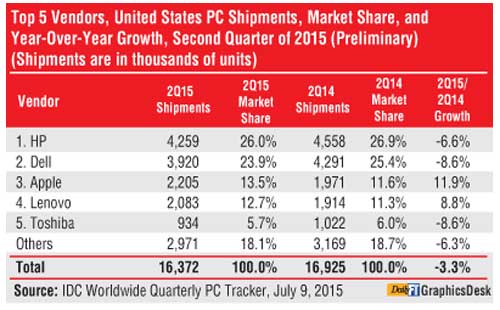Thursday Dec 12, 2024
Thursday Dec 12, 2024
Tuesday, 14 July 2015 00:22 - - {{hitsCtrl.values.hits}}
Worldwide PC shipments totalled 66.1 million units in the second quarter of 2015 (2Q15), according to the International Data Corporation (IDC) Worldwide Quarterly PC Tracker. This represented a year-on-year decline of -11.8%, about 1% below projections for the quarter.
The slow PC shipments were largely anticipated as a result of stronger year-ago shipments relating to end of support for windows XP as well as channels reducing inventory ahead of the release of Windows 10.
In addition, weaker or changing exchange rates for foreign currencies have effectively increased PC prices in many markets, thereby  reducing purchasing power and also complicating investment planning.
reducing purchasing power and also complicating investment planning.
“Although the second quarter decline in PC shipments was significant, and slightly more than expected, the overall trend fits with expectations,” said Loren Loverde, Vice President, Worldwide PC Trackers & Forecasting. “We continue to expect low to mid-single digit declines in volume during the second half of the year with volume stabilising in future years. We’re expecting the Windows 10 launch to go relatively well, though many users will opt for a free OS upgrade rather than buying a new PC. Competition from 2-in-1 devices and phones remains an issue, but the economic environment has had a larger impact lately, and that should stabilize or improve going forward.”
“The US market was in line with forecasts, declining -3.3% from a year ago, after avoiding the global market declines over the past five quarters. Soft retail demand, short term weakness from inventory reductions, some cannibalisation from competing devices, and low demand for large commercial refreshes are among the factors that reduced PC shipments,” said Rajani Singh, Senior Research Analyst, Personal Computers.
“Nevertheless, moving forward, we expect a healthy second half as inventory and purchase decisions pick up following the launch of Windows 10. Emerging product categories will remain a bright spot as attention shifts to convertibles and Chromebooks in the commercial as well as consumer segments.”
Regional Highlights
Asia/Pacific (excluding Japan) – China was impacted by excess commercial notebook inventory from earlier quarters as the anti-corruption campaign continues to suppress commercial spending. Currency fluctuation also remained a key factor in many countries in the region, contributing to lower demand. Nevertheless, volume was close to expectations, reflecting a slight decline in growth from prior quarters.
Japan – continued to see low growth as the weak Yen contributed to a difficult market. The Japanese PC market faced a particularly difficult comparison to year ago shipments that were boosted by the end of support for Windows XP and also changes to Japan’s tax  code. As the market responds to these shifts and managing inventory, Yamada Denki (one of Japan’s major electronics stores) announced the closure of unprofitable stores in both urban and rural markets.
code. As the market responds to these shifts and managing inventory, Yamada Denki (one of Japan’s major electronics stores) announced the closure of unprofitable stores in both urban and rural markets.
United States – With shipments totalling nearly 16.4 million PCs in 2Q15, the US market shrank -3.3% from the same quarter a year ago. Although most vendors saw volume decline, gains from Apple and Lenovo helped limit the overall decline. A tough year-on-year comparison contributed to a decline in desktop shipments, while portable PCs shipments continued to grow.
Europe, Middle East, and Africa (EMEA) – In EMEA, weakening demand and high inventory levels inhibited sell-in, driving results below expectations. Vendors continued to clean stock ahead of the back-to-school season and Windows 10 launch. Moreover, unfavourable exchange rates led to increasing prices and continued to affect demand both in the business and consumer spaces. The commercial market also faced a difficult year-on-year comparison with 2Q14, when the end of support for Windows XP boosted sales.
Vendor highlights
Lenovo held onto the top position with shipments of 13.4 million units. Volume was up 1% from the prior quarter, but down -7.5% from the prior year. The vendor continued to aggressively court expansion outside of Asia/Pacific, leading to share gains in the US and EMEA.
HP remained the number 2 vendor, but saw shipments decline -10.4% from a year ago. Slowing business demand and inventory control of entry notebooks contributed to the dip. While most of the slowdown was from outside of the US, the vendor also saw its US volume contract nearly -7%.
Dell came in at number 3, shipping more than 9.5 million units and registering a year-over-year decline of -8.7%. Strong results in 2Q14 contributed to a poor year-over-year comparison. Stronger performance in Asia/Pacific and EMEA were offset by slower growth in the US. Apple continued to outperform other vendors, with growth of 16.1% globally. The vendor has largely avoided the price competition affecting other players and may be benefitting from some of the uncertainty around the launch of Windows 10, along with refreshed products like the 12-inch MacBook and a relative concentration of shipments in the US.
Acer continued to see growth in Chromebooks with more models introduced. However, the vendor also struggled with the larger pullback in the market, particularly in EMEA where it had seen a rebound in mid-2014. The vendor ended 2Q14 with a volume of 4.33 million, a significant decline from the prior quarter and year ago volumes.
ASUS was statistically tied with Acer for the number 5 position. ASUS has also been affected by currency factors and inventory management, but strong growth in the US boosted overall results.